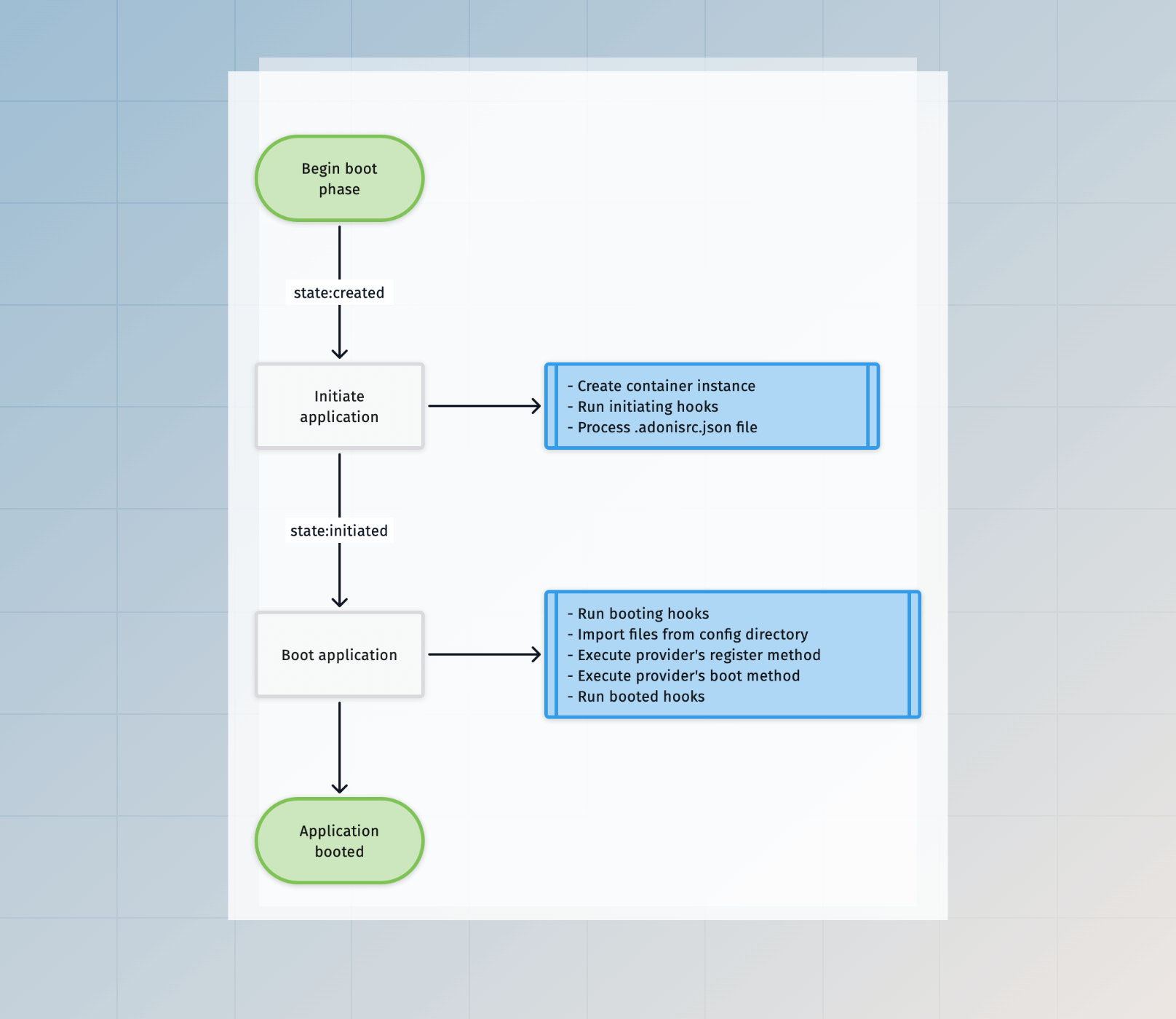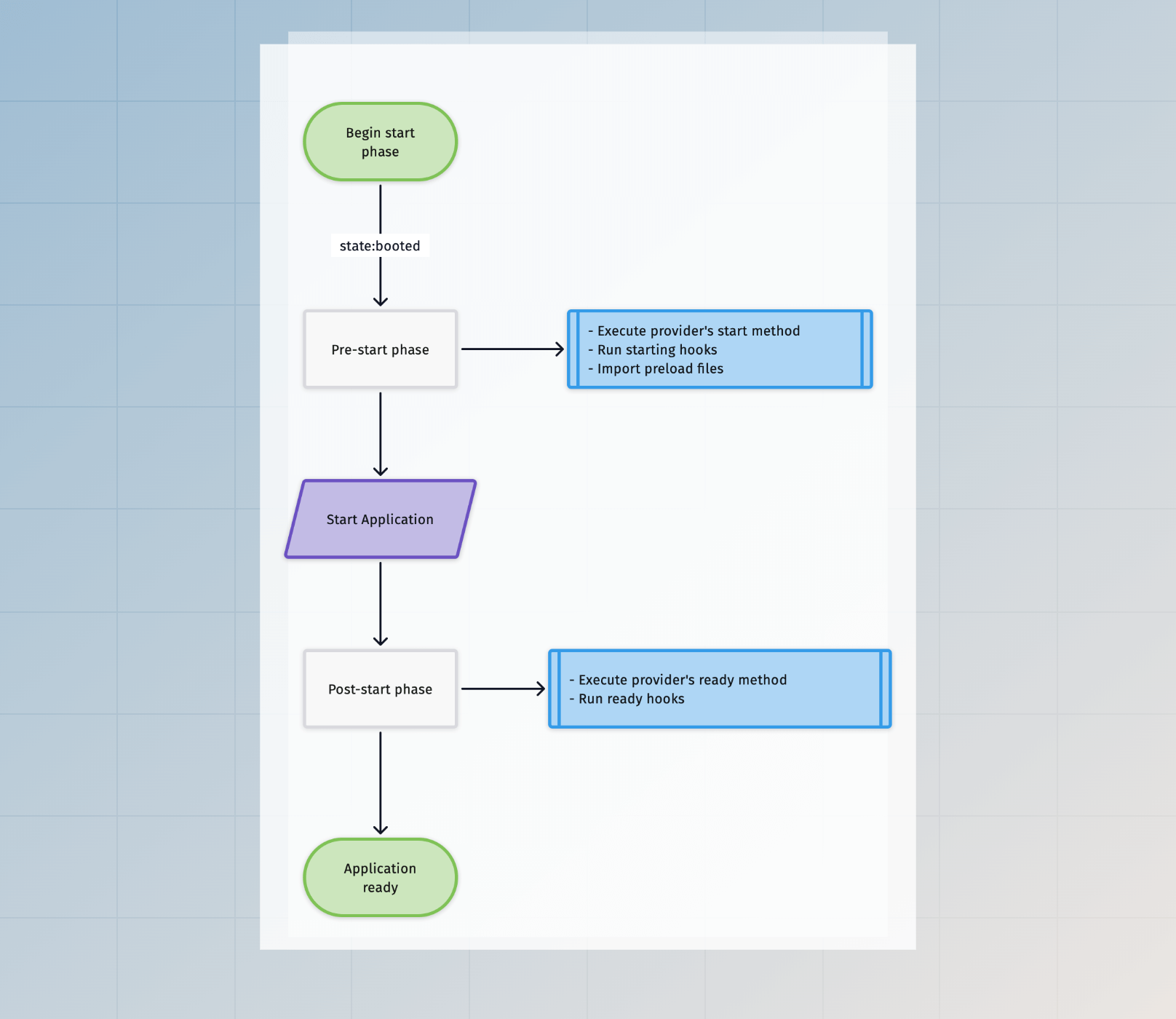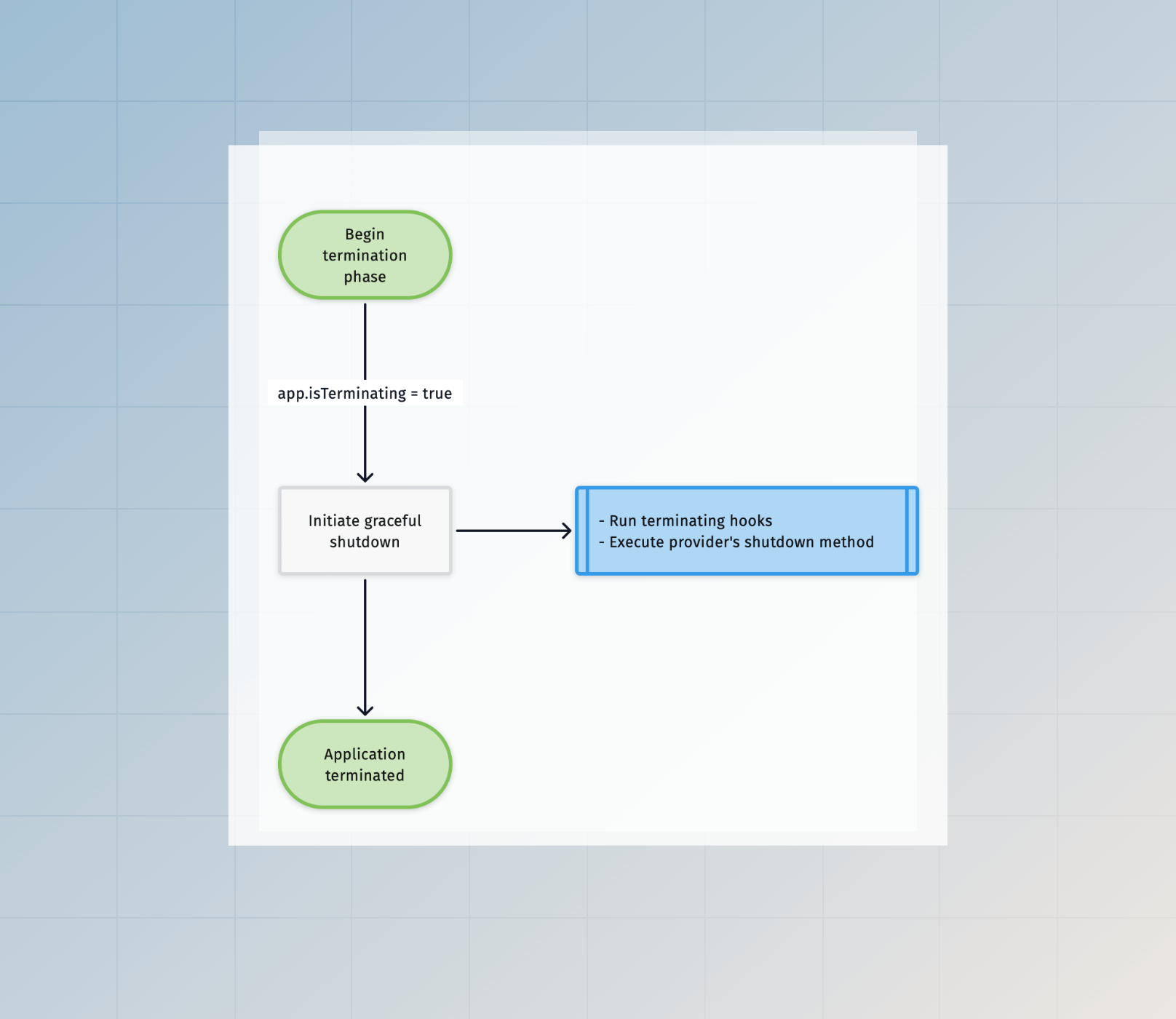Application lifecycle
In this guide, we will learn how AdonisJS boots your application and what lifecycle hooks you can use to change the application state before it is considered ready.
The lifecycle of an application depends upon the environment in which it is running. For example, a long-lived process started to serve HTTP requests is managed differently from a short-lived ace command.
So, let's understand the application lifecycle for every supported environment.
How an AdonisJS application gets started
An AdonisJS application has multiple entry points, and each entry point boots the application in a specific environment. The following entrypoint files are stored inside the bin directory.
- The
bin/server.tsentry point boots the AdonisJS application to handle HTTP requests. When you run thenode ace servecommand, behind the scenes we run this file as a child process. - The
bin/console.tsentry point boots the AdonisJS application to handle CLI commands. This file uses Ace under the hood. - The
bin/test.tsentrypoint boots the AdonisJS application to run tests using Japa.
If you open any of these files, you will find us using the Ignitor module to wire things up and then start the application.
The Ignitor module encapsulates the logic of starting an AdonisJS application. Under the hood, it performs the following actions.
- Create an instance of the Application class.
- Initiate/boot the application.
- Perform the main action to start the application. For example, in the case of an HTTP server, the
mainaction involves starting the HTTP server. Whereas, in the case of tests, themainaction involves running the tests.
The Ignitor codebase is relatively straightforward, so browse the source code to understand it better.
The boot phase
The boot phase remains the same for all the environments except the console environment. In the console environment, the executed command decides whether to boot the application.
You can only use the container bindings and services once the application is booted.

The start phase
The start phase varies between all the environments. Also, the execution flow is further divided into the following sub-phases
-
The
pre-startphase refers to the actions performed before starting the app. -
The
post-startphase refers to the actions performed after starting the app. In the case of an HTTP server, the actions will be executed after the HTTP server is ready to accept new connections.

During the web environment
In the web environment, a long-lived HTTP connection is created to listen for incoming requests, and the application stays in the ready state until the server crashes or the process receives a signal to shut down.
During the test environment
The pre-start and the post-start actions are executed in the test environment. After that, we import the test files and execute the tests.
During the console environment
In the console environment, the executed command decides whether to start the application.
A command can start the application by enabling the options.startApp flag. As a result, the pre-start and the post-start actions will run before the command's run method.
import { BaseCommand } from '@adonisjs/core/ace'
export default class GreetCommand extends BaseCommand {
static options = {
startApp: true
}
async run() {
console.log(this.app.isReady) // true
}
}
The termination phase
The termination of the application varies greatly between short-lived and long-lived processes.
A short-lived command or the test process begins the termination after the main operation ends.
A long-lived HTTP server process waits for exit signals like SIGTERM to begin the termination process.

Responding to process signals
In all the environments, we begin a graceful shutdown process when the application receives a SIGTERM signal. If you have started your application using pm2, the graceful shutdown will happen after receiving the SIGINT event.
During the web environment
In the web environment, the application keeps running until the underlying HTTP server crashes with an error. In that case, we begin terminating the app.
During the test environment
The graceful termination begins after all the tests have been executed.
During the console environment
In the console environment, the termination of the app depends on the executed command.
The app will terminate as soon as the command is executed unless the options.staysAlive flag is enabled, and in this case, the command should explicitly terminate the app.
import { BaseCommand } from '@adonisjs/core/ace'
export default class GreetCommand extends BaseCommand {
static options = {
startApp: true,
staysAlive: true,
}
async run() {
await runSomeProcess()
// Terminate the process
await this.terminate()
}
}
Lifecycle hooks
Lifecycle hooks allow you to hook into the application bootstrap process and perform actions as the app goes through different states.
You can listen for hooks using the service provider classes or define them inline on the application class.
Inline callbacks
You should register lifecycle hooks as soon as an application instance is created.
The entry point files bin/server.ts, bin/console.ts, and bin/test.ts creates a fresh application instance for different environments, and you can register inline callbacks within these files.
const app = new Application(new URL('../', import.meta.url))
new Ignitor(APP_ROOT, { importer: IMPORTER })
.tap((app) => {
app.booted(() => {
console.log('invoked after the app is booted')
})
app.ready(() => {
console.log('invoked after the app is ready')
})
app.terminating(() => {
console.log('invoked before the termination starts')
})
})
-
initiating: The hook actions are called before the application moves to the initiated state. Theadonisrc.tsfile is parsed after executing theinitiatinghooks. -
booting: The hook actions are called before booting the app. The config files are imported after executingbootinghooks. -
booted: The hook actions are invoked after all the service providers have been registered and booted. -
starting: The hook actions are invoked before importing the preload files. -
ready: The hook actions are invoked after the application is ready. -
terminating: The hook actions are invoked once the graceful exit process begins. For example, this hook can close database connections or end open streams.
Using service providers
Services providers define the lifecycle hooks as methods in the provider class. We recommend using service providers over inline callbacks, as they keep everything neatly organized.
Following is the list of available lifecycle methods.
import { ApplicationService } from '@adonisjs/core/types'
export default class AppProvider {
constructor(protected app: ApplicationService) {}
register() {
}
async boot() {
}
async start() {
}
async ready() {
}
async shutdown() {
}
}
-
register: The register method registers bindings within the container. This method is synchronous by design. -
boot: The boot method is used to boot or initialize the bindings you have registered inside the container. -
start: The start method runs just before thereadymethod. It allows you to perform actions that thereadyhook actions might need. -
ready: The ready method runs after the application is considered ready. -
shutdown: The shutdown method is invoked when the application begins the graceful shutdown. You can use this method to close database connections, or end opened streams.